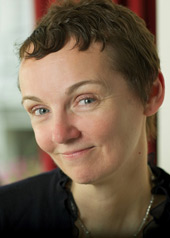Apple strudel...and what that has to do with improvements in diabetes care
 So we’re writing from Café Mozart in Vienna while we’re here for the annual meeting of the European Association for the Study of Diabetes. We’re eating strudel. Apple strudel. Because we can. My CGM says 91 and my blood glucose monitor says 93 and I just took Symlin. Yes, we’ve come a long way from the mid-1980s, when I was diagnosed, when doctors looked away when I said I wanted to have kids, when plenty of people in the waiting rooms of UMass and the Joslin Diabetes Center were blind, had amputations, and talked in hushed whispers. When I took 8 units of NPH and 4 units of regular every morning and every night, no matter what my blood glucose meter said, no matter what I was eating (carbs? I had no idea), no matter how stressed I was, no matter whether I was exercising or not (I wasn’t). This evening, I’m eating strudel. My peak blood glucose isn’t breaking 130 mg/dl (that’s 7.3 mmol/l for those of us not stateside), and I walked two miles today between all the sessions and our little apartment we found on the edge of the city. I’m feeling on the positive side of this diabetes stuff.
So we’re writing from Café Mozart in Vienna while we’re here for the annual meeting of the European Association for the Study of Diabetes. We’re eating strudel. Apple strudel. Because we can. My CGM says 91 and my blood glucose monitor says 93 and I just took Symlin. Yes, we’ve come a long way from the mid-1980s, when I was diagnosed, when doctors looked away when I said I wanted to have kids, when plenty of people in the waiting rooms of UMass and the Joslin Diabetes Center were blind, had amputations, and talked in hushed whispers. When I took 8 units of NPH and 4 units of regular every morning and every night, no matter what my blood glucose meter said, no matter what I was eating (carbs? I had no idea), no matter how stressed I was, no matter whether I was exercising or not (I wasn’t). This evening, I’m eating strudel. My peak blood glucose isn’t breaking 130 mg/dl (that’s 7.3 mmol/l for those of us not stateside), and I walked two miles today between all the sessions and our little apartment we found on the edge of the city. I’m feeling on the positive side of this diabetes stuff.
But sometimes I wonder how much progress we’ve really made. On the plane over, I sat next to a cardiologist who had just been to a major interventional cardiology meeting in San Francisco. We started chatting because I was calibrating my continuous glucose monitor (he was impressed with the accuracy) and finishing Dr. David Kessler’s amazing The End of Overeating: Taking Control of the Insatiable American Appetite, and I asked him if he had any people with diabetes in his practice. He just stared at me. I asked him again, and he sputtered, “Almost all my patients are diabetic! Almost all of them!” He then allowed that maybe the percentage was maybe 60-70%. I then asked if he knew what the problems were. He stared again. “Do they have normal A1cs?” I asked. He didn’t know precisely (read: at all), but he said he was sure they were all out of control “or I wouldn’t have met them in the first place!” What are their problems? Another stare. “Is it fasting blood glucose or after meals mostly?” He had no idea. I asked him if he prescribed Byetta or metformin or sulfonylureas. He said, almost disgustedly, “I stay out of all that. I’m busy. I have so many procedures to do. I get them to their endocrinologist as fast as I can! I don’t have time to manage that.”
Yes, a discouraging encounter. For all our improvements in devices and drugs, we still have a huge gap in knowledge and education. I just wish that cardiologist would have attended the American Association of Diabetes Educators (AADE) Conference in Atlanta, where he would have learned that diabetes care subsists on education. We need the procedures, but we need even more the self-care to prevent the procedures.
This issue of diaTribe places a heavy emphasis on education, including Conference Pearls from the AADE meeting. We also have an interview with Mary Sullivan, AADE’s educator of the year; Gary Scheiner’s great advice on seeing your educator; and Kerri Morrone Sparling’s column on how to educate friends and coworkers. James Hirsch has also written about “The Midnight Hour” at his home, when it’s time for his son’s final blood check.
So, go forth, learn, and may wisdom be the key to a long life and plenty of strudel.
Best wishes,
Kelly L. Close







